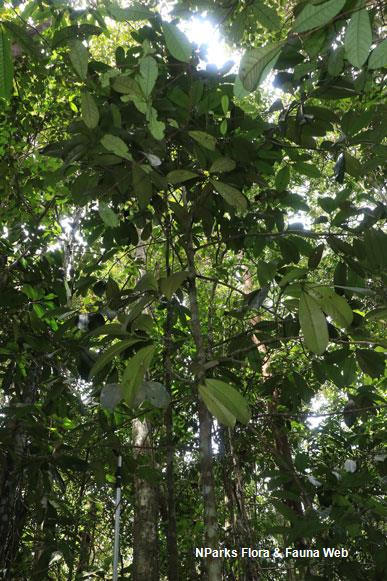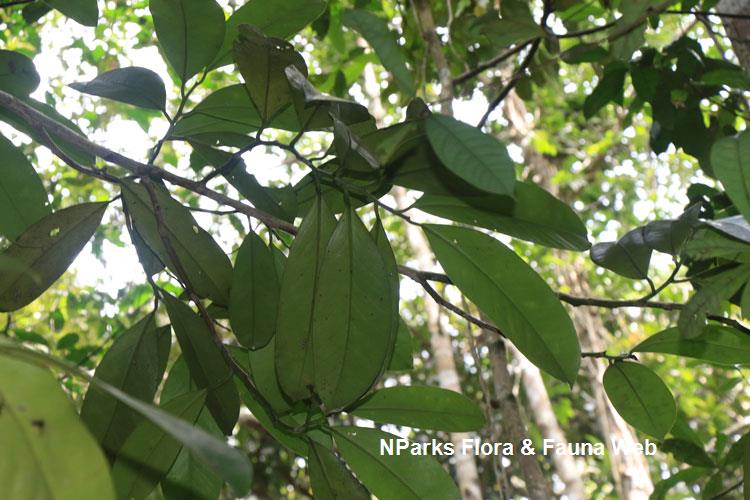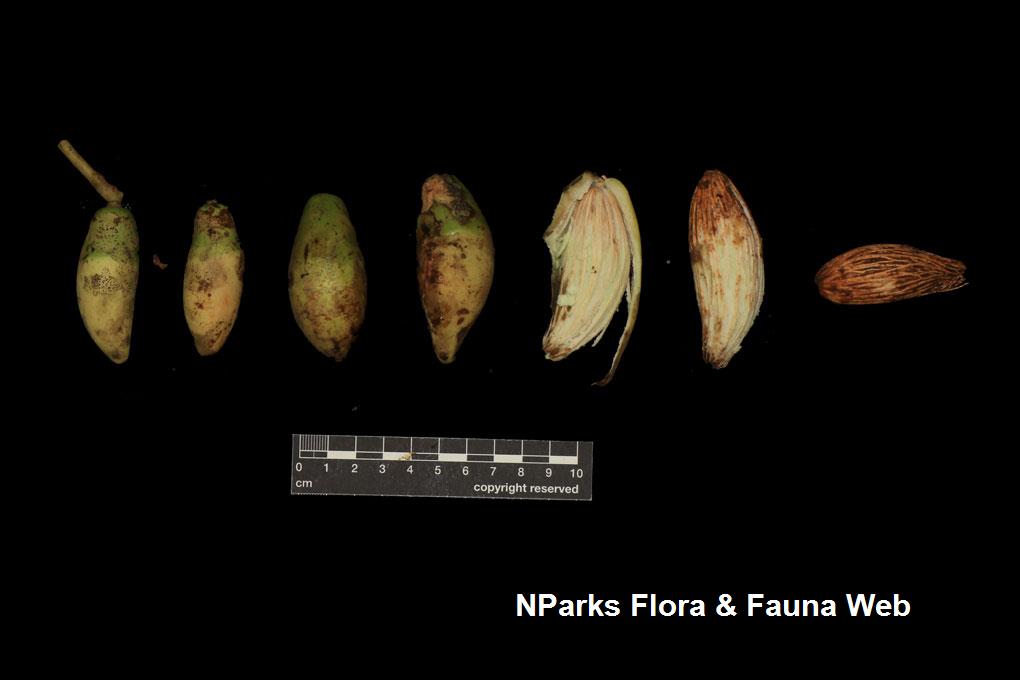
Back
Stemonurus scorpioides Becc.
| Family Name: | Stemonuraceae |
| Synonyms: | Stemonurus secundiflorus auct. non Blume <3>, Lasianthera secundiflora auct. non (Blume) Miq. <1> |
Stemonurus scorpioides is large tree native to Singapore. Growing to 35 m tall, it has stiff, leathery, elliptic-oblong leaves with margins that curves inwards. Flowers are white, cream to greenish coloured, 4 - 5 petalled, held on an scorpion-like inflorescence found along the axils. The fruit is an oval to elliptic drupe with a tapering tip, whitish above, dark green to purplish below.
Name
Classifications and Characteristics
| Plant Division | Angiosperms (Flowering Seed Plants) (Dicotyledon) |
|---|---|
| Plant Growth Form | Tree (Big (>30m)) |
| Maximum Height | 35 m |
Biogeography
| Native Distribution | Sumatra, Lingga and Riou Archipelago, Banka, Malay Peninsula, Borneo, Singapore |
|---|---|
| Native Habitat | Terrestrial (Primary Rainforest, Secondary Rainforest) |
| Preferred Climate Zone | Tropical |
| Local Conservation Status | Native to Singapore (Critically Endangered (CR)) |
Description and Ethnobotany
| Growth Form | It is a large tree that grows between 10 - 35 m tall, blunt asparagus-like breathing roots might be observed. |
|---|---|
| Foliage | Leaves are stiff, leathery, elliptic-oblong, glossy, dark green above, pale below measuring 11 - 30 cm long by 6 - 11 cm wide. Margins are curved inwards, veinlets are fine and ladder-like above. |
| Flowers | Flowers are held on an scorpion-like inflorescence found along the axils. 6 - 10 flowers are directly attached to stalk on each side. Flowers are 4-5 petalled, white to cream or greenish coloured, sitting within a cup-shaped base. |
| Fruit | The fruit is a oval to elliptic drupe with a tapering tip, measuring 4.5 - 6.5 cm long by 2 - 3 cm wide. The drupe is whitish above, dark green to purplish in the lower third, with some vertical grooves on the surface. |
| Habitat | Occurs commonly in peat swamp forest, swampy areas and secondary forests. |
| Cultivation | It can be propagated by seed. |
| Etymology | The genus epithet, Stemonurus; Greek stemon-stamen; urus-tailed referring to the bearded anthers. The species epithet, scorpioides; Latin meaning scorpion-like referring to the inflorescence). |
| Ethnobotanical Uses | Timber & Products: The timber is soft, less durable and may crack, hence often used for planks and household utensils. <2 & 4> |
Plant Care and Propagation
| Light Preference | Full Sun |
|---|---|
| Water Preference | Moderate Water |
| Plant Growth Rate | Moderate |
| Rootzone Tolerance | Fertile Loamy Soils, Moist Soils, Well-Drained Soils |
| Propagation Method | Seed |
Foliar
| Foliage Retention | Evergreen |
|---|---|
| Foliar Type | Simple / Unifoliate |
| Foliar Arrangement Along Stem | Alternate |
| Foliar Attachment to Stem | Petiolate |
| Foliar Shape(s) | Non-Palm Foliage (Elliptical, Oblong) |
| Foliar Venation | Reticulate |
| Foliar Margin | Entire |
| Foliar Apex - Tip | Acute |
| Foliar Base | Cuneate |
Non - Foliar and Storage
| Stem Type & Modification | Woody |
|---|---|
| Root Type | Underground |
Floral (Angiosperm)
| Flower & Plant Sexuality | Bisexual Flowers , Bisexual Flowers |
| Flower Colour(s) | Cream / Off-White |
|---|
| Flower Grouping | Cluster / Inflorescence |
| Flower Location | Axillary |
| Flower Symmetry | Radial |
| Flowering Habit | Polycarpic |
Fruit, Seed and Spore
| Mature Fruit Colour(s) | Cream / Off-White, Purple, Green |
|---|---|
| Fruit Classification | Simple Fruit |
| Fruit Type | Fleshy Fruit , Drupe |
| Mature Seed Texture(s) | Ridged / Corrugated |
| Seed Quantity Per Fruit | Few (1-5) |
References
| References | <1> King, G. et. al. (1895). Flora of the Malayan Peninsula. Journal of the Asiatic Society of Bengal 74(2): 117. <2> Kochummen, K.M. (1978). Icacinaceae. Tree Flora of Malaya, vol. 3, pp. 117. Kuala Lumpur, Longman Malaysia. <3> Ridley, H.N. et. al (1922). The flora of Malay Peninsula, vol. 1. London: L. Reeve & Co., Ltd. pp. 430. <4> Ridley, H.N. et. al (1923). The flora of Malay Peninsula, vol. 5. London: L. Reeve & Co., Ltd. pp. 296. |
|---|
Image Repository
Others
| Master ID | 30435 |
|---|---|
| Species ID | 4744 |
| Flora Disclaimer | The information in this website has been compiled from reliable sources, such as reference works on medicinal plants. It is not a substitute for medical advice or treatment and NParks does not purport to provide any medical advice. Readers should always consult his/her physician before using or consuming a plant for medicinal purposes. |


